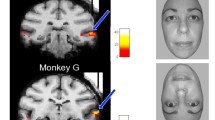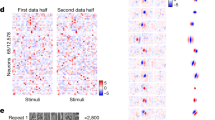Abstract
To analyze the information provided about individual visual stimuliin the responses of single neurons in the primate temporal lobevisual cortex, neuronal responses to a set of 65 visual stimuli wererecorded in macaques performing a visual fixation task and analyzedusing information theoretical measures. The population of neuronsanalyzed responded primarily to faces. The stimuli included 23 facesand 42 nonface images of real-world scenes, so that the function ofthis brain region could be analyzed when it was processing relativelynatural scenes.
It was found that for the majority of the neurons significantamounts of information were reflected about which of several of the23 faces had been seen. Thus the representation was not local, forin a local representation almost all the information available canbe obtained when the single stimulus to which the neuron respondsbest is shown. It is shown that the information available about anyone stimulus depended on how different (for example, how manystandard deviations) the response to that stimulus was from theaverage response to all stimuli. This was the case for responsesbelow the average response as well as above.
It is shown that the fraction of information carried by the lowfiring rates of a cell was large—much larger than that carried bythe high firing rates. Part of the reason for this is that theprobability distribution of different firing rates is biased towardlow values (though with fewer very low values than would bepredicted by an exponential distribution). Another factor is thatthe variability of the response is large at intermediate and highfiring rates.
Another finding is that at short sampling intervals (such as 20 ms)the neurons code information efficiently, by effectively acting asbinary variables and behaving less noisily than would be expectedof a Poisson process.
Similar content being viewed by others
References
Baddeley R (1996) An efficient code in V1? Nature381:560–561.
Baddeley, R.J., Abbot, L.F., Booth, M.J.A., Sengpiel, F., Freeman, T., Wakeman, E.A., and Rolls, E.T. (1998) Responses of neurons in primary and inferior temporal visual cortices to natural scenes. Proceedings of the Royal Society B, in press.
Baizer JS, Ungerleider LG, Desimone R (1991) Organization of visual inputs to the inferior temporal and posterior parietal cortex in macaques. J. Neurosci.11:168–190.
Barlow HB (1972) Single units and sensation: A neuron doctrine for perceptual psychology? Perception1:371–394.
Barnes CA, McNaughton BL, Mizumori SJ, Lim LH (1990) Comparison of spatial and temporal characteristics of neuronal activity in sequential stages of hippocampal processing. Prog. Brain Res. 83:287–300.
Baylis GC, Rolls ET, Leonard CM (1985) Selectivity between faces in the responses of a population of neurons in the cortex in the superior temporal sulcus of the monkey. Brain Res.342:91–102.
Baylis GC, Rolls ET, Leonard CM (1987) Functional subdivisions of temporal lobe neocortex. J. Neurosci.7:330–342.
Bialek W(1991) Optimal signal processing in the nervous system. In: W Bialek, ed. Princeton Lectures on Biophysics. World Scientific, London.
Bruce C, Desimone R, Gross CG (1981)Visual properties of neurons in a polysensory area in superior temporal sulcus of the macaque. J. Neurophysiol46:369–384.
Churchland PS, Sejnowski TJ (1992) The Computational Brain. MIT Press, Cambridge, MA.
Desimone R (1991) Face-selective cells in the temporal cortex of monkeys. J. Cog. Neurosci.3:1–8.
Desimone R, Gross CG (1979) Visual areas in the temporal lobe of the macaque. Brain Res.178:363–380.
Desimone R, Albright TD, Gross CG, Bruce C (1984) Stimulusselective properties of inferior temporal neurons in the macaque. J. Neurosci.4:2051–2062.
Fukunaga K (1972) Introduction to Statistical Pattern Recognition. Academic Press, New York.
Golomb D, Hertz J, Panzeri S, Richmond BH, Treves A (1997) How well can we estimate the information carried in neuronal responses from limited samples? Neural Computation, 9:649–665.
Gross CG (1992) Representation of stimuli in inferior temporal cortex. Phil. Trans. Roy. Soc. Lond. B335:3–10.
Gross CG, Desimone R, Albright TD, Schwartz EL (1985) Inferior temporal cortex and pattern recognition. Exp. Brain Res. Suppl. 11:179–201.
Hinton GE, McClelland JL, Rumelhart DE (1986) Distributed representations. In: DE Rumelhart, JL McClelland, eds. Parallel Distributed Processing, MIT Press, Cambridge, MA. pp. 77–109.
Hornak J, Rolls ET, Wade D (1996) Face and voice expression identification and their association with emotional and behavioural changes in patients with ventral frontal lobe damage. Neuropsychologia 34:247–261.
Jung MW, McNaughton BL (1993) Spatial selectivity of unit activity in the hippocampal granular layer. Hippocampus3:165–182.
Leonard BW, McNaughton BL (1990) Spatial representation in the rat: Conceptual, behavioral and neurophysiological perspectives. In: RP Kesner, DS Olton, eds. Neurobiology of Comparative Cognition. Erlbaum, Hillsdale, NJ.
Levy WB, Baxter RA (1996) Energy efficient neural codes. Neural Computation8:531–543.
Macrae AW (1971) On calculating unbiased information measures. Psychol. Bull.75:270–277.
Maunsell JHR, Newsome WT (1987) Visual processing in monkey extrastriate cortex. Ann. Rev. Neurosci.10:363–401.
Optican L, Richmond BJ (1987) Temporal encoding of twodimensional patterns by single units in primate inferior temporal cortex. III. Information theoretic analysis. J. Neurophysiol. 57:132–146.
Optican LM, Gawne TJ, Richmond BJ, Joseph PJ (1991) Unbiased measures of transmitted information and channel capacity from multivariate neuronal data. Biol. Cyber.65:305–310.
Panzeri S, Treves A (1996) Analytical estimates of limited sampling biases in different information measures. Network7:87–107.
Panzeri S, Biella G, Rolls ET, Skaggs WE, Treves A (1996a) Speed, noise, information and the graded nature of neuronal response. Network7:365–370.
Panzeri S, Booth M, Wakeman EA, Rolls ET, Treves A (1996b) Do firing rate distributions reflect anything beyond just chance? Society for Neuroscience Abstracts22:445.5.
Perrett DI, Rolls ET, Caan W (1982) Visual neurons responsive to faces in the monkey temporal cortex. Exp. Brain Res.47:329–342.
Richmond BJ, Optican L (1987) Temporal encoding of twodimensional patterns by single units in primate inferior temporal cortex. II. Quantification of response waveform. J. Neurophysiol. 57:147–161.
Richmond BJ, Optican LM, Podell M, Spitzer H (1987) Temporal encoding of two-dimensional patterns by single units in primate inferior temporal cortex. I. Response characteristics. J. Neurophysiol. 57:132–146.
Rieke F, Warland D, De RuyterVan Steveninck RR, Bialek W (1996) Spikes: Exploring the Neural Code. MIT Press, Cambridge, MA.
Rolls ET (1981a) Processing beyond the inferior temporal visual cortex related to feeding, learning, and striatal function. In: Y Katsuki et al., eds. Brain Mechanisms of Sensation. Wiley, New York, pp. 241–269.
Rolls ET (1981b) Responses of amygdaloid neurons in the primate. In: Y Ben-Ari, eds. The Amygdaloid Complex. Elsevier, Amsterdam. pp. 383–393.
Rolls ET (1984) Neurons in the cortex of the temporal lobe and in the amygdala of the monkey with responses selective for faces. Human Neurobiol.3:209–222.
Rolls ET (1989) Functions of neuronal networks in the hippocampus and neocortex in memory. In: JH Byrne, WO Berry, eds. Neural Models of Plasticity: Experimental and Theoretical Approaches. Academic Press, San Diego. pp. 240–265.
Rolls ET (1991) Neural organisation of higher visual functions. Curr. Opinion in Neurobiol.1:274–278.
Rolls ET (1992a) Neurophysiological mechanisms underlying face processing within and beyond the temporal cortical visual areas. Phil. Trans. Roy. Soc.335:11–21.
Rolls ET (1992b) The processing of face information in the primate temporal lobe. In: V Bruce, M Burton, eds. Processing Images of Faces. Ablex, Norwood NJ. pp. 41–68.
Rolls ET (1992c) Neurophysiology and functions of the primate amygdala. In: JP Aggleton, ed. The Amygdala, Wiley-Liss, New York. pp. 143–165.
Rolls ET (1994) Brain mechanisms for invariant visual recognition and learning. Behavioural Processes33:113–138.
Rolls ET (1995) Learning mechanisms in the temporal lobe visual cortex. Behav. Brain Res.66:177–185.
Rolls ET, Baylis GC (1986) Size and contrast have only small effects on the responses to faces of neurons in the cortex of the superior temporal sulcus of the monkey. Exp. Brain Res.65:38–48.
Rolls ET, Miyashita Y, Cahusac PMB, Kesner RP, Niki H, Feigenbaum J, Bach L (1989) Hippocampal neurons in the monkey with activity related to the place in which a stimulus is shown. J. Neurosci.9:1835–1845.
Rolls ET, O’Mara S (1993) Neurophysiological and theoretical analysis of how the hippocampus functions in memory. In: T Ono, LR Squire, ME Raichle, DI Perrett, M Fukuda, eds. Brain Mechanisms of Perception and Memory: From Neuron to Behavior, Oxford University Press, New York. pp. 276–300.
Rolls ET, Treves A (1990) The relative advantages of sparse versus distributed encoding for associative neuronal networks in the brain. Network1:407–421.
Rolls ET, Tovee MJ (1995a) The responses of single neurons in the temporal visual cortical areas of the macaque when more than one stimulus is present in the visual field. Exp. Brain Res.103:409–420.
Rolls ET, Tovee MJ (1995b) The sparseness of the neuronal representation of stimuli in the primate temporal visual cortex. J. Neurophysiol.73:713–726.
Rolls, E.T., Treves, A. (1998) Neural Networks and Brain Function. Oxford University Press, Oxford.
Seltzer B, Pandya DN (1978) Afferent cortical connections and architectonics of the superior temporal sulcus and surrounding cortex in the rhesus monkey. Brain Res.149:1–24.
Skaggs WE, McNaughton BL, Gothard KM, Markus EJ (1993) An information-theoretic approach to deciphering the hippocampal code. In: SJ Hanson, JD Cowan, CL Giles, eds. Advances in Neural Information Processing Systems 5. Morgan Kaufman, San Mateo. pp. 1030–1037.
Smith DV, Travers JB (1979) A metric for the breadth of tuning of gustatory neurons. Chem. Senses4:215–229.
Suga N (1989) Principles of auditory information-processing derived from neuroethology. J. Exp. Biol.146:277–286.
Tanaka K, Saito H-A, Fukada Y, Moriya M (1991) Coding visual images of objects in the inferotemporal cortex of the macaque monkey. J. Neurophysiol.66:170–189.
Tovee MJ, Rolls ET, Treves A, Bellis RP (1993) Information encoding and the responses of single neurons in the primate temporal visual cortex. J. Neurophysiol.70:640–654.
Tovee MJ, Rolls ET, Azzopardi P (1994) Translation invariance and the responses of neurons in the temporal visual cortical areas of primates. J. Neurophysiol.72:1049–1060.
Tovee MJ, Rolls ET (1995) Information encoding in short firing rate epochs by single neurons in the primate temporal visual cortex. Visual Cognition2:35–58.
Treves A (1990) Graded-response neurons and information encodings in autoassociative memories. Physical Review A42:2418–2430.
Treves A, Panzeri S (1995) The upward bias in measures of information derived from limited data samples. Neural Computation 7:399–407.
Treves A, Rolls ET (1991) What determines the capacity of autoassociative memories in the brain? Network2:371–397.
Treves A, Rolls ET (1994) A computational analysis of the role of the hippocampus in memory. Hippocampus4:374–391.
Weiskrantz L, Saunders RC (1984) Impairments of visual object transforms in monkeys. Brain107:1033–1072.
Author information
Authors and Affiliations
Rights and permissions
About this article
Cite this article
Rolls, E.T., Treves, A., Tovee, M.J. et al. Information in the Neuronal Representation of Individual Stimuli in the Primate Temporal Visual Cortex. J Comput Neurosci 4, 309–333 (1997). https://doi.org/10.1023/A:1008899916425
Issue Date:
DOI: https://doi.org/10.1023/A:1008899916425




